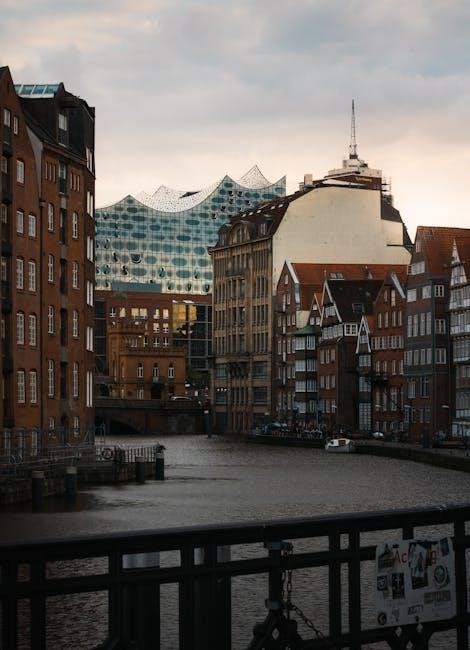Overview of “The House on Mango Street”
Sandra Cisneros’s The House on Mango Street‚ published in 1984‚ is a poignant novel following Esperanza Cordero’s coming-of-age. Set in Chicago’s Hispanic quarter‚ it explores identity and belonging through vignettes. Rooted in Cisneros’s experiences‚ the story captures a young Chicana’s dreams and struggles for a better life.

Synopsis of the Story
The House on Mango Street unfolds through the eyes of Esperanza Cordero‚ a young girl navigating adolescence in a Chicago Latino neighborhood. The narrative‚ structured as a series of vignettes‚ captures moments from her life on Mango Street‚ detailing the struggles‚ dreams‚ and realities of her community.
Esperanza grapples with her identity as a Chicana‚ her longing for a better home‚ and her desire to escape the cycle of poverty and limited opportunities that surround her. She observes the lives of the women around her‚ witnessing their resilience‚ their trapped circumstances‚ and their hopes for something more.
Through encounters with neighbors‚ friends‚ and family‚ Esperanza learns about love‚ loss‚ and the complexities of womanhood. She witnesses the effects of societal expectations and the challenges faced by women in her community. As she grows‚ Esperanza begins to find her own voice and envision a different future for herself‚ one where she can break free from Mango Street and forge her own path.
Ultimately‚ the story is about Esperanza’s journey of self-discovery‚ her growing awareness of the world around her‚ and her determination to create a life of her own choosing‚ while remaining connected to her roots.

Esperanza Cordero’s Character Development
Esperanza Cordero‚ the protagonist of The House on Mango Street‚ undergoes significant transformation throughout the novel. Initially‚ she is a young‚ naive girl grappling with feelings of displacement and a longing for a true home. Living on Mango Street‚ she feels ashamed of her family’s poverty and the dilapidated house they inhabit.
As Esperanza matures‚ she becomes increasingly aware of the social and gender inequalities that define her world. She observes the limited opportunities available to the women around her‚ who are often trapped in cycles of abuse or dependence. These observations fuel her desire to escape Mango Street and create a better life for herself.
Esperanza’s writing becomes a crucial outlet for her emotions and a tool for self-discovery. Through her poems and stories‚ she explores her identity‚ her dreams‚ and her frustrations. She learns to find strength in her voice and to use her words to challenge the constraints placed upon her.
By the end of the novel‚ Esperanza has developed a strong sense of self and a determination to leave Mango Street‚ but also to return and help others. She embraces her heritage and recognizes the importance of community‚ vowing to use her experiences to empower other young women.
Themes in “The House on Mango Street”
The House on Mango Street explores themes of identity‚ poverty‚ and gender roles. Esperanza’s journey highlights the struggle for self-discovery within a marginalized community. The novel examines the impact of societal expectations and the yearning for a better future‚ free from limitations.
Identity and Self-Discovery
Esperanza Cordero’s journey in The House on Mango Street centers around the complex process of identity formation and self-discovery. As a young Chicana girl growing up in a marginalized community‚ Esperanza grapples with defining herself amidst societal expectations and personal aspirations. Her name‚ “Esperanza‚” meaning hope in English and sadness in Spanish‚ symbolizes her internal conflict.
The vignettes reveal Esperanza’s evolving understanding of her cultural heritage‚ her sexuality‚ and her place in the world. Through her interactions with other women on Mango Street‚ she witnesses the constraints and limitations imposed upon them‚ fueling her desire to forge her own path. Esperanza’s writing becomes a tool for self-expression and a means of claiming her identity.
She rejects the traditional roles assigned to women in her community‚ aspiring to a life of independence and self-determination. Her dreams of owning a house represent her longing for a space where she can define herself on her own terms. Ultimately‚ Esperanza’s journey is a testament to the power of self-discovery in overcoming adversity and embracing one’s true identity.
Poverty and Social Class
The House on Mango Street vividly portrays the realities of poverty and its impact on the lives of the residents. The novel highlights the systemic inequalities faced by the Chicano community in Chicago‚ revealing how economic hardship shapes their opportunities and aspirations. The dilapidated houses‚ limited resources‚ and lack of access to quality education underscore the challenges of living in a marginalized neighborhood.
Esperanza’s experiences reflect the daily struggles of families striving to make ends meet. The shame associated with poverty is evident in her desire to escape Mango Street and create a better future for herself. The novel explores how poverty affects individuals’ sense of self-worth and their ability to dream beyond their immediate circumstances.
The characters’ resilience in the face of adversity is a testament to their strength and determination. Despite the limitations imposed by their social class‚ they find ways to support each other and maintain hope. Cisneros’s portrayal of poverty is not merely a depiction of hardship but also a celebration of the community’s ability to persevere and find joy amidst challenges.
Gender Roles and Expectations
The House on Mango Street critically examines the restrictive gender roles imposed on women within the Chicano community. Esperanza witnesses the limitations placed on women‚ often confined to the domestic sphere and expected to prioritize marriage and family over personal aspirations. The novel explores the consequences of these expectations‚ highlighting the frustration and lack of agency experienced by many women.
Esperanza’s desire to break free from these traditional roles is a central theme. She observes the lives of women like her great-grandmother‚ trapped in unhappy marriages‚ and resolves to forge her own path. Her ambition to own a house and achieve independence symbolizes her rejection of the conventional expectations placed upon her.
The novel also portrays women who challenge these norms in various ways‚ offering Esperanza alternative models of female empowerment. Through these characters‚ Cisneros explores the complexities of female identity and the possibilities for women to assert their independence and pursue their dreams. Esperanza’s journey is one of self-discovery‚ as she navigates the conflicting expectations and ultimately defines her own version of womanhood.

Literary Style and Structure
Cisneros employs a distinctive literary style in The House on Mango Street. The novel is structured as a series of vignettes‚ short‚ impressionistic scenes that capture moments in Esperanza’s life. This fragmented structure mirrors her evolving understanding of herself and the world around her.
Vignette Style
The House on Mango Street utilizes a vignette style‚ presenting a series of short‚ descriptive scenes that collectively form a narrative. Each vignette functions as a snapshot‚ capturing a specific moment‚ character‚ or theme in Esperanza’s life. These vignettes are often poetic and evocative‚ relying on imagery and symbolism to convey deeper meanings. The fragmented nature of the vignette style mirrors Esperanza’s own fragmented sense of self and her evolving understanding of the world around her.
Unlike a traditional novel with a linear plot‚ The House on Mango Street progresses through these interconnected vignettes. Each vignette contributes to the overall story‚ revealing different aspects of Esperanza’s experiences‚ her community‚ and her dreams. This structure allows Cisneros to explore a wide range of themes and perspectives‚ creating a rich and complex portrait of life on Mango Street.
The vignette style also allows for a more intimate and personal reading experience. By focusing on small‚ specific moments‚ Cisneros invites the reader to connect with Esperanza on an emotional level. The reader experiences the world through Esperanza’s eyes‚ sharing her joys‚ sorrows‚ and struggles as she navigates the challenges of adolescence and identity.
Use of Language and Imagery
Sandra Cisneros masterfully employs vivid language and striking imagery in The House on Mango Street to create a powerful and evocative reading experience. Her writing is characterized by its poetic quality‚ using metaphors‚ similes‚ and symbolism to convey complex emotions and ideas. The language reflects the cultural context of Mango Street‚ incorporating Spanish phrases and a distinctly Chicana voice.
Imagery plays a crucial role in bringing the world of Mango Street to life. Cisneros uses sensory details to paint a vivid picture of the neighborhood‚ from the sights and sounds of the bustling streets to the smells of cooking and the textures of the houses. These images create a strong sense of place‚ immersing the reader in Esperanza’s environment.
Symbolism is also prevalent throughout the novel. The house on Mango Street itself serves as a symbol of Esperanza’s dreams and aspirations‚ as well as her feelings of confinement and dissatisfaction. Other recurring symbols‚ such as hair‚ windows‚ and shoes‚ further contribute to the novel’s thematic depth‚ exploring themes of identity‚ gender‚ and social class.
The combination of evocative language and powerful imagery makes The House on Mango Street a truly memorable and impactful work of literature.

Availability of “The House on Mango Street” in PDF Format
The House on Mango Street‚ by Sandra Cisneros‚ is widely accessible in PDF format across various online platforms. Many websites offer free downloads of the book for educational or personal use. These digital versions provide a convenient way to access the text on computers‚ tablets‚ and e-readers‚ making it easy for students and readers to engage with the story.
However‚ it’s crucial to ensure that downloading a PDF copy complies with copyright laws. Some websites may offer unauthorized versions‚ while others provide legitimate access through libraries or educational institutions. Always prioritize downloading from reputable sources to respect the author’s rights and avoid potential legal issues.
Several online libraries and digital archives also offer The House on Mango Street in PDF format‚ often requiring a free account or subscription. These platforms provide a wealth of resources‚ including access to classic and contemporary literature. Before downloading‚ verify the source’s credibility and legality to guarantee a safe and ethical reading experience.
Ultimately‚ the PDF availability of The House on Mango Street enhances its accessibility‚ allowing a broader audience to discover and appreciate Cisneros’s powerful narrative.




